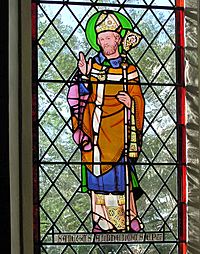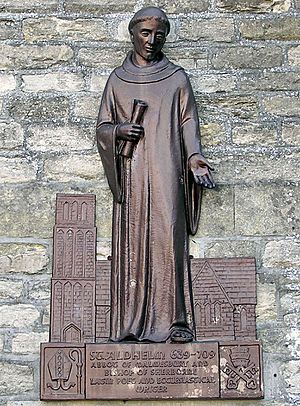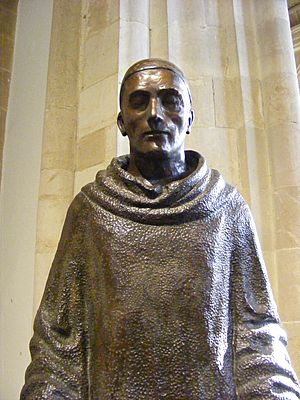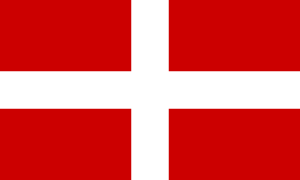Aldhelm facts for kids
Quick facts for kids Saint Aldhelm |
|
|---|---|
| Bishop of Sherborne, Abbot of Malmesbury Abbey | |

Stained glass window showing Aldhelm, installed in St Aldhelm's Church, Malmesbury in 1938
|
|
| Diocese | Sherborne |
| Successor | Forthhere |
| Other posts | Abbot of Malmesbury (675-705) |
| Personal details | |
| Born | c. 639 Wessex |
| Died | 25 May 709 Doulting, Somerset |
| Denomination | Roman Catholic |
| Sainthood | |
| Feast day | 25 May |
| Venerated in | Roman Catholic Church Eastern Orthodox Church Anglican Communion |
| Attributes | Monk playing a harp; or bishop with staff sprouting ash leaves |
| Patronage | Malmesbury; Sherborne; musicians; songwriters |
| Shrines | Malmesbury Abbey, now destroyed. |
Aldhelm (also known as Ealdhelm or Aldhelmus Malmesberiensis) was an important English scholar, writer, and church leader. He was born around the year 639 and died on May 25, 709.
Aldhelm served as the Abbot of Malmesbury Abbey and later as the Bishop of Sherborne. He was also known for his skill in writing Latin poetry. People believed he came from the royal family of Wessex. After his death, he was honored as a saint, and his feast day is celebrated on May 25.
Contents
Life
Early Education
Aldhelm began his education at a school run by an Irish monk named Máeldub. This school was located in a place that later became known as Malmesbury.
In 668, a new Archbishop, Theodore of Tarsus, came to Canterbury. A North African scholar named Hadrian also became an abbot there. Aldhelm studied with Hadrian, even though he was already about 30 years old.
His studies included many subjects like Roman law, astronomy, and how to figure out the calendar. He also learned some Greek and Hebrew words, which he used in his writings.
Aldhelm eventually had to leave Canterbury because of poor health. He returned to Malmesbury Abbey and became a monk there. He stayed at Malmesbury for about 14 years.
Abbot of Malmesbury
When Máeldub died in 675, Aldhelm took over as the head of the monastery. He became its first abbot.
Aldhelm brought in the Rule of St Benedict, which was a set of rules for monks to live by. He also made sure the monks could choose their own abbot. The monastery at Malmesbury grew, and Aldhelm started two more learning centers. These were at Frome, Somerset, and Bradford-on-Avon, Wiltshire.
He even traveled to Rome and got permission from Pope Sergius I to build the monastery at Frome. The old Anglo-Saxon church at St Laurence's Church, Bradford-on-Avon is believed to be from his time. At Malmesbury, he built a new church and got a lot of land for the monastery. Aldhelm remained abbot until about 705.

Bishop of Sherborne
Around 705, the large area of Winchester was divided into two church regions. Aldhelm became the first bishop of the new region, called Sherborne.
He wanted to stop being the abbot of Malmesbury, but the monks asked him to stay. So, he continued to lead both until his death. Even though he was old, he worked very hard as a bishop. He built a new church at Sherborne, which was later replaced.
Aldhelm was known for going into public places. He would sing hymns and parts of the gospels. Sometimes he would even do funny things to get people's attention. This helped him share his message with more people.
Organ Building
It is said that Aldhelm built an amazing organ. He described it as "a mighty instrument, with countless sounds, blown with bellows, and enclosed in a gilded case." This shows his interest in music and new inventions.
Death and Being Honored as a Saint

Aldhelm died in 709 while visiting churches in his region. He passed away at the church in Doulting village. The Church of St Aldhelm and St Aldhelm's Well in Doulting are named after him.
His body was taken to Malmesbury for burial. His friend, Egwin, who was the Bishop of Worcester, placed crosses at each place where his body rested along the way. Aldhelm was buried in the church of St Michael at Malmesbury Abbey.
People believed that miracles happened because of his holiness, both during his life and at his burial place. A cape in Dorset is often called St. Alban's Head, but its proper name is St. Aldhelm's Head, in his honor.
Aldhelm was honored as a saint after his death. His feast day is celebrated on May 25. His holy remains were moved in 980 by Dunstan, the Archbishop of Canterbury. There is a statue of him at Salisbury Cathedral and another at Sherborne Abbey.
There is even a flag for Saint Aldhelm. It has a white cross on a red background. This is like the flag of England (St. George's flag), but with the colors reversed. The Church of England remembers him on May 25.
Writings
His Reputation as a Scholar
Aldhelm was famous as a scholar, and his reputation spread to other countries. Even the son of an Irish king, Artwil, asked Aldhelm to check his writings.
Aldhelm was the first Anglo-Saxon person known to write poetry in Latin. He wrote a guide about Latin poetry for his countrymen. In this guide, he included his most famous works: one hundred and one riddles in Latin. Each riddle was like a complete picture.
Even Bede, another famous scholar of that time, called Aldhelm "a wonder of learning." His fame reached Italy, and he visited Rome at the request of Pope Sergius I. When he returned, he was welcomed like a hero.
Aldhelm wrote in a very fancy and sometimes difficult Latin style. This style was popular in England for a long time. His works were used as textbooks in monastery schools.
His Books and Poems
- De Laude Virginitatis (On the Praise of Virginity): This was a Latin book about virginity, written for nuns. Aldhelm also wrote a shorter, poetic version of this work.
- Epistola ad Acircium (Letter to Acircius): This was a Latin book dedicated to King Aldfrith of Northumbria. It included three parts:
- De septenario: About the number seven.
- De metris: About poetry and how to measure lines.
- De pedum regulis: About different types of poetic feet (rhythms).
- Other Letters: Aldhelm wrote many letters to important people. One interesting letter was to Eahfrid, a scholar who had just returned from Ireland. This letter helps us understand the relationship between English and Irish scholars back then.
Lost Works
Aldhelm also wrote poetry in Old English. He even set his own songs to music. None of these songs have survived, but they were still popular during the time of King Alfred. It is said that he would stand at the end of a bridge and sing songs in English. This would gather a crowd, and then he would talk to them about religious topics.
Churches dedicated to St Aldhelm
-
St Aldhelm's Church, Belchalwell, Dorset
-
Bishopstrow, Wiltshire
-
St Aldhelm's Church, Boveridge, Dorset
-
Chilcompton, Somerset
-
Church of St Aldhelm, Doulting, Somerset
-
St Aldhelm's Church, Lytchett Heath, Dorset
-
St Aldhelm's Church, Radipole, Dorset
-
Sandleheath, Hampshire
-
St. Aldhelm's Chapel, Worth Matravers, Dorset
See Also
 In Spanish: Aldhelmo de Sherborne para niños
In Spanish: Aldhelmo de Sherborne para niños
- Leiden Glossary
















